Short Book Reviews
Hanna Kryszewska, Poland
Hanna Kryszewska is a teacher, teacher trainer, trainer of trainers. She is a senior lecturer at the University of Gdańsk, and EU Teacher Training College where she trains pre-service teachers. She is co-author of resource books: Learner Based Teaching, OUP, Towards Teaching, Heinemann, The Standby Book, CUP, Language Activities for Teenagers, CUP, The Company Words Keep, DELTA Publishing, and a course book series for secondary schools: ForMat, Macmillan. She is also co-author of a video based teacher training course: Observing English Lessons. Hania is a Pilgrims trainer and editor of HLT Magazine.
E-mail: hania.kryszewska@pilgrims.co.uk
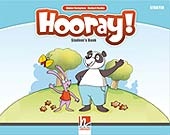
Hooray! Starter Interactive Book G. Gerngross and H. Puchta (2012) Helbling Languages. ISBN 978-3-85272-446-1. This hybrid CD is a DVD and CD-ROM which contains materials for the Horray! Starter course, part one of a 3-level course for young learners (2013 ELTons winner for Excellence and Innovation). There are three major parts: a video tutorial, teacher’s resources and the student’s book. The seven-minute tutorial talks you through all the components. The teacher’s resource contains a browsable teacher’s book, flashcards, story cards, a cartoon DVD, a teacher training video, audio tracks, letters to parents, and extra worksheets. The interactive student’s book contains the six main units and two extra units in interactive form. The tutorial explains the role of each tab and how to navigate throughout the course and the wealth of materials. Additionally there is an Interactive Book for Whiteboards which contains a detailed video tutorial explaining how whiteboards can be used e.g. how to access the teacher’s notes, how to drag and drop, add and erase elements to the pictures, how to play the audio material or how to check the correct answers. Overall it is a truly state-of-the-art resource for the 21st century classroom. No need to carry around resources, equipment and other teaching aids. All you need is the CD.
For an HLT review of the course: Hooray!: Starter Student’s Book, Hooray! Starter Teacher’s Book, Hooray! Let’s play. Teacher’s Bookclick here
Zlinkuj do http://old.hltmag.co.uk/dec12/pubs01.htm
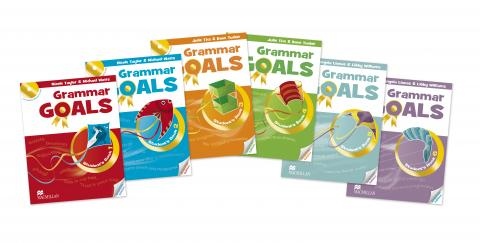
Grammar GOALS. Pupil’s Book 1-6 British Edition. N. Taylor and M. Watts (SB 1-2), J. Tice and D. Tucker (SB 3-4) and A. Llanas and L. Williams (SB 5-6), (2014) Macmillan. ISBN 978-0-230-44569-7, ISBN 978-0-230-44576-5, ISBN 978-0-230-44583-3, ISBN 978-0-230-44590-1, ISBN 978-0-230-44597-0, ISBN 978-0-230-44604-5 (respectively) pp. 80-96. The Grammar GOAL series of grammar books consist of six parts, and is aimed at young learners. It offers supplementary resource books which can be combined with any young learner’s course book. The teacher can choose the right level for his or her learners dipping into the books whenever suitable. The levels range from pre-A1 to B1. Particular grammar structures are introduced or revised through reading and listening input, and then practised in a variety of ways which involve reading, listening, writing and speaking. The exercises are very motivating thanks to the ample use of visual material in the form of drawings or photographs. The authors also include exercises focusing on pronunciation and punctuation. The book is divided into good size units and contains regular revision sections. From book to book the texts become longer as the structures become more complex, and new types of grammar exercises appear, ranging from filling in gaps, choosing the right word order, students writing their own sentences with a given structure to sentence transformation, multiple-close tests and putting the verbs in the right tense. At higher levels there is also more focus on writing (Writings goal sections) and topics related to culture and CLIL. The grammar resource books series is a very good supplementary material for learners preparing for the Cambridge English Young Learners English Tests: Starters, Movers and Flyers tests; at the higher levels they are also suitable for learners preparing for the Key/ Preliminary for Schools (KET/PET). Highly recommended.
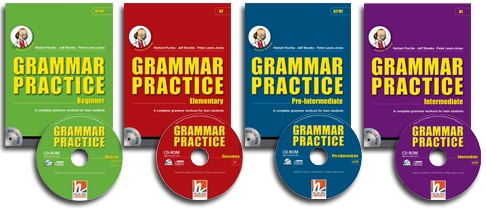
Grammar Practice Pre-Intermediate and Grammar Practice Intermediate. H. Puchta, J. Stranks and P. Lewis-Jones. Helbling Languages (year of publication not given). ISBN 978-3-85772-462-3, ISBN 978-3-85772-427-0, pp 80 and pp 88 (respectively). The Grammar Practice series of grammar books consist of four parts, and is aimed at teenage learners – level Al/A2 to B1. For each grammar area the books offer a summary of rules the learners need to know at their level, and a wide variety of grammar exercises. The exercises are motivating and supported by relevant visual material. Additionally the books are accompanied by CD-ROMs with extra material and suggest strategies how learners can effectively master the grammar material through the use of listening material with ample use of the given grammar structure, relevant animated cartoons, what the authors call Tricky Grammar Tests, and cartoons for fun. The books have a unique feature ELT materials rarely have, namely a letter to the students. Often there is a message to the teachers, however, learners who are an important party in the teaching-learning process are often neglected. Here the authors devote a whole page to communicate with the learners explaining the rationale of the book, the need for regular practice, and tips how to use the book. I am sure the learners will appreciate the attention they have received, especially if the teacher highlights this unique feature and devotes some time to it in class.
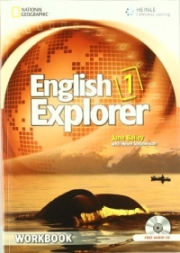
English Explorer 4: Student’s Book. H. Stephenson, (2012) ISBN 978-1-111-22304-5, pp.128. This course book is part 4 of a four level general English course which is aimed at students at secondary level (According to the information on the cover the book in question is aimed at the B1 level according to CEFR). The course has a highly communicative and skills based approach which is the springboard for grammar and vocabulary work in context. The book uses stunning National Geographic photography and stories ‘bringing real people, real places and real stories into the classroom’. The choice of texts and genres is very varied and interesting, with a strong CLIL element. The learners explore amazing places and cultures, learn how to use the language and develop practical language skills as well as thinking skills. The book consists of 8 modules devoted to mass media, the mind, archaeology, jobs, materials, art and books, science and technology, politics, shops and services and money. Additionally the student’s book contains a picture dictionary with exercises, grammar reference, 4 review modules, video worksheets, culture sections, true stories and projects. The layout of the book and the visual materials other than those from the National Geographic are varied and pleasing to the eye. The course book comes with a MultiCD-ROM with National Geographic videos, audio recordings for pronunciation practice, computer based vocabulary practice, as well as grammar and comprehension activities. The course also includes the usual components like the workbook, a National Geographic DVD, the teacher’s book with audio CD’s, and a teacher’s resource book.
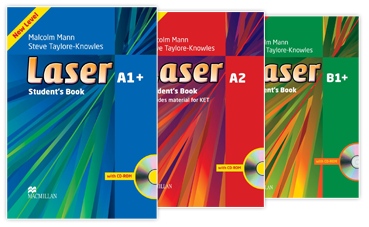
Laser: Student’s Books B1, B1+ and B2. M. Mann and S. Taylore-Knowles (first published 2004, republished 20130) ISBN 978-0-230-43352-6, 978-0-230-43467-0, 978-0-230-43382-3,
978-0-230-43420-2, 978-0-230-43426-4, 978-0-230-43426-4, 978-0-230-42740-2, 978-0-230-43432-5; pp.207, 204, 214 respectively. This three part general English course is aimed at teenagers from B1 to B2 level according to CEFR. The course reflects the needs and interests of the learners. Each course book is divided into sixteen topic based units with comprehensive skills coverage, grammar and vocabulary practice. The topics are relevant to this particular age group and include cross-curricular and intercultural content, as well as tasks which require the use of English in the learners’ own environment. The course has a skills based approach, in which language functions, grammar and lexis are closely linked to the skills themselves. Production of language requires speaking and writing using motivating activities close to life. The strong points of the course are: the dictionary corner sections, the phrase bank sections, the soundstation sections, revision units, writing planners, databases with lexical patterns and collocations, additional material in workbooks, a student’s CD-ROM, and an extensive teacher’s book with a final test and a test generator. The books in the course are pleasing to the eye with a clear layout and reasonably good photography and drawings. The course looks fresh and up-to date. I am unable to judge how much of the original course has been changed and up-dated in the revised edition.

Skillful ... Series. Macmillan Academic Skills: Skillful Listening & Speaking. Foundation. D. Bohlke (2013) Macmillan. ISBN 978-0-230-43343-3, pp 110. Skillful Reading & Writing Foundation. D. Bohlke (2013) Macmillan. ISBN 978-0-230-433444-0, pp 110. Skillful Listening & Speaking 4. L. Clandfield and M. McKinnon. (2014) Macmillan. ISBN 978-0-230-43197-3, pp 109. Skillful Reading & Writing 4. M. Boyle and L. Warwick. (2014) Macmillan. ISBN 978-0-230-43198-0, pp 109. These four titles are two new levels in the Skillful series. These are the awaited level 4 and foundation course, which means that now the five level course is complete. It is aimed at students who want to prepare for the IELTS exam. Thanks to the fact that there are so many levels of the course teachers will be able to choose the right book for their students. If the need arises it is possible to use in the same class, say, a reading and writing book at level 3 and a listening and speaking book at level 2. Each unit regardless of the level gives a clear presentation, instant practice and skills integration. The texts and tasks are interesting, well chosen and suitable for the IELTS context. The books are ideal for short intensive exam preparation courses. Unfortunately I cannot find information stating which level corresponds to what band in the exam grading scale. Like all recently published Macmillan titles, the Skillful course has an online component.
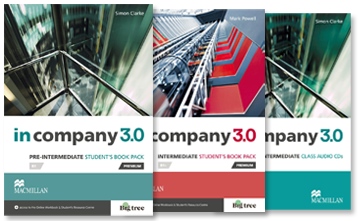
in company 3.0 Pre-Intermediate. Student’s Book Pack. S. Clarke. Macmillan. (first published 2003, this edition 2014), ISBN 978-0-230-45511-5, pp. 158. in company 3.0 Intermediate. Student’s Book Pack. M. Powell. Macmillan. (first published 2003, this edition 2014), ISBN 978-0-230-45511-5, pp. 158, and in company 3.0 Upper Intermediate. Student’s Book Pack. M. Powel and J. Allison. Macmillan. (first published 2003, this edition 2014), ISBN 978-0-230-45535-1, pp. 158 These three course books are part of a five part revised 2003 course (the Starter level is new and has been added to the 2013 course). The In Company course has been highly successful and now it has been updated to suit the needs of learners who want to make the best of blended learning. The content of the books has been updated and expanded, however, like the previous editions, it has a strong, skills-based approach. The language presented in each unit revolves around ‘business trends, people skills and everyday business scenarios’. So the learners can see immediate practical and professional application of the language they learn. The strength of the new edition is the use it makes of blended learning, i.e. using traditional in-class teaching with on-line learning. The publishers offer an innovative integrated Online Workbook and a Student’s Resource Centre which are available through the new Big tree learning platform. More innovations include: business scenarios with challenging video case studies which resemble real-life business situations, extensive video footage, and video interviews featuring global business professionals, and texts and audio materials coming from a range of international sources. The Teacher’s Resource Centre provides easy access to class audio, more video footage, additional photocopiable materials: classroom activities, tests and worksheets. This is a truly modern course, and I am sure both the learners and the teacher will benefit immensely from using the book (the teacher by using or becoming familiar with state-of-the-art educational technology, the students by learning in a modern blended learning classroom). Highly recommended.
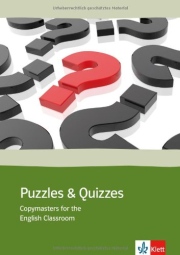
Puzzles & Quizzes. Copymasters for the English Classroom. D. Shallis. Klett (2013), ISBN 978-3-12-534606-2, pp. 88. This book is a collection of photocopiable materials which can be used with individual learners as well as groups of learners. They can be used to start or end a lesson, to revise vocabulary or grammar structures, work on pronunciation and homophones, fluency practice, and provide information on English speaking countries. The activities involve playing games e.g. a language version of battleships, quizzes, completing worksheets, crossword puzzles, word searches, and many others. The material is very teacher friendly. Each activity occupies one two page spread; the left-hand side contains the teacher’s notes and the key, while the right-hand side is the photocopiable sheet itself. The target level of the learners ranges from elementary+ to intermediate+, and the time the activities may take ranges from 15 to 30 minutes. I am sure each teacher will find something suitable for their learners.
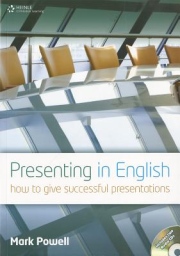
Presenting in English. How to give successful presentations. M. Powell. Heinle CENGAGE (2011), ISBN 978-1-111-83227-8, pp. 2128. This book is intended for learners who want to work on their presentation skills and who want to give successful presentations at conferences and meetings. The book consists of seven units of varying lengths devoted to topics like: getting started, exploiting visuals, using voice, basic presentation techniques, more advanced techniques, key language, and handling questions. The book is very practical and uses real language used by professional speakers, presents techniques they use to handle an audience, and how they use rhetorical language. The book is easy to use, and it could be used in class or for self study thanks to the key at the end of the book. The activities are varied and engaging, and the generous layout gives ample space to write the answers in the book. The book is accompanied by two CD’s which contain the listening material; unfortunately there is no transcript at the end of the book. The cartoons at the beginning of each section are witty and the layout is neat, although there is too much pink to my liking.
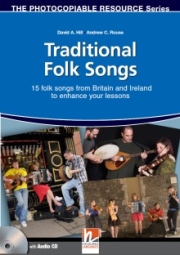
Traditional Folk Songs. D. A. Hill and A. C. Rouse. Helbling Languages. (2012). ISBN 978-3-85272-4336-1, pp168. This resource book has been published in the popular Photocopiable Resource series which is written be leading ELT authors. Like other books in the series, this resource book offers ready-to-use and innovative activities to use with 15 traditional songs from Britain and Ireland, e.g. Scarborough Fair, The Trees They Grow High, The Wild Rover, Wild Mountain Thyme, and Cockles and Mussels. The treatment of each song is a far cry from how other similar resource books on using songs treat the subject. A typical unit will have a Content and Language Integrated learning (CLIL) component, for example for the song Scarborough Fair it will be history of medieval fairs and information on the use of herbs; there is also language and vocabulary work, comprehension tasks checking the understanding of the lyrics, further exploration of the song and its lyrics, and, finally, there is the Performers’ Corner introducing some bands and singers. What is particularly worth mentioning is the hybrid CD-Rom which contains the recording of the songs performed by the authors and their bands, as well as links to live video and audio performances of the songs by contemporary bands and links to any relevant websites. For each song there are also music sheets and complete lyrics.
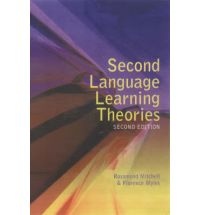
Second Language Learning Theories. Third Edition. R. Mitchell, F. Myles and E. Marsden. (2013) Routledge ISBN 978-1-4441-6310-0, pp 379. This is the third revised edition; you may be familiar with the 1998 or 2004 editions. The book offers a clear and concise overview of current theories on second language acquisition (SLA), presents key concepts and issues, and the recent history of second language learning research. Various SLA theories are presented from different perspectives: linguistics and language learning, cognitive approaches, meaning-based, socio-cultural and socio-linguistic perspectives. What stands out in this edition when compared to the previous ones are the chapters on cognitive models, information processing, and a new timeline of second language learning theories. The glossary of key linguistic terms will aid the less experienced reader in the field of SLA and linguistics in general. Overall the book is highly informative and presents our current knowledge on second language acquisition.
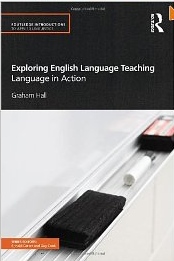
Exploring English Language Teaching. Language in Action. G. Hall. (2011) ISBN 978-0-415-58415-9, pp.282. Routledge. The book was published in the well established Routledge Introductions to Applied Linguistics series (series editors R. Carter and G. Cook). The book addresses all the key topics which we currently believe are of vital importance in teaching English such as: classroom interaction and management, relationships, methods, post-methods and methodology, the learner, learner diversity and development, various ways of viewing the learner, institutional frameworks and social contexts. It is aimed at both undergraduate and postgraduate students, as well as language professionals who are returning to academic study. This is why the treatment of the topics is different from and more in-depth than their treatment in publications aimed at CELTA or DELTA candidates. The book will also be very useful for teacher trainers and educators delivering courses on English Language Teaching (ELT) and Language Teacher Education.

Please check the Methodology and Language for Kindergarten Teachers course at Pilgrims website.
Please check the Methodology and Language for Primary Teachers course at Pilgrims website.
Please check the Methodology and Language for Secondary Teachers course at Pilgrims website.
Please check the Teaching Advanced Students course at Pilgrims website.
Please check the CLIL for Universities course at Pilgrims website.
Please check the ICT - Using Technology in the Classroom – Level 1 course at Pilgrims website.
Please check the ICT - Using Technology in the Classroom – Level 2 course at Pilgrims website.
Please check the Using Interactive Whiteboards course at Pilgrims website.
Please check the Creative Methodology for the Classroom course at Pilgrims website.
Please check the Teaching English Through Music & Art course at Pilgrims website.
Please check the Practitioner Course in Developing Business English Skills course at Pilgrims website.


|